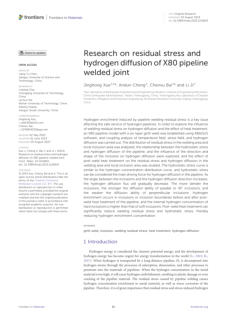Underwater construction 2023










Publisher: Parker hydraulics
Parker is a reputed manufacturer of hydraulic and
pneumatic systems.
This document provides various formulas, equations, and
conversion tables that can be used to engineer the
systems mentioned above.
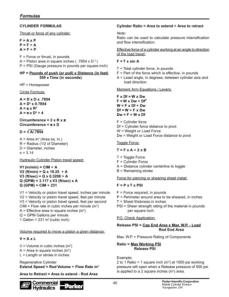


Publisher: Jun Yu, Hai-tao Li, Zhen-xin Sheng, et al.
In this study, the cavitation effect induced by two charges
in underwater explosions near free surfaces is numerical
researched by two dimensional compressible multi-phase
fluids based on a four-equation system with a phase
transition model. The occurrence of the generation,
development, and collapse of cavitation in two-charge
underwater explosions near free surfaces can be captured
directly. The detailed density,pressure, and vapor volume
fraction contours during the interaction process are
obtained and can better reveal the characteristic
underlying the cavitation, free surface, and explosion
bubbles.
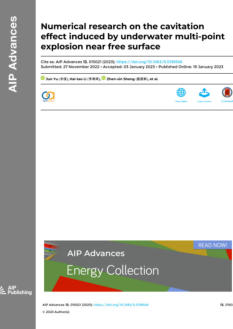


Publisher: Mao Zhi-yuan, Duan Chao-wei, Hu Hong-wei,
Feng Hai-yun, Song Pu
This paper summarizes the typical experiments of
underwater explosion power evaluation, discusses the
power characterization methods involved in the tests,
and focuses on the explosion bulge test of plate structure
and its corresponding dimensionless deflection
characterization means.



Authors: D Chen, L J Zhang, Y Z Lv, B H Li, H P Gu
This paper relates a series of studies are carried out on
underwater explosions with different grid sizes, so as to
obtain the corresponding
recommended grids that meet the calculation accuracy.
The influence of different water state equations on the
simulation results is discussed. The effect of artificial
viscosity coefficient on the simulation results is analyzed.
Finally, the similarity law of the model is studied to verify
the universality of the model parameters.
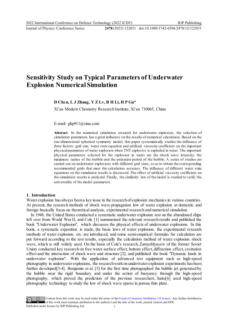


Authors: T Ma , J X Wang, L T Liu, H Li, Y C Gu, & Y F
Zhang
This document provides a methodology to provide a
theoretical basis for studying the shock wave propagation
and evolution generated by cylindrical charge of near-
field underwater explosion
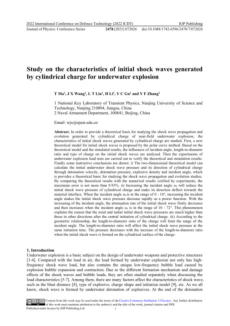


Authors: Ming He, Shuai Zhang, Shi-ping Wang, Ze-yu
Jin, Hemant Sagar
The current work, a refined numerical study of the fl ow-
field characteristics of a large equivalent shallow-depth
explosion is carried out using a self-developed Eulerian
finite element solver.

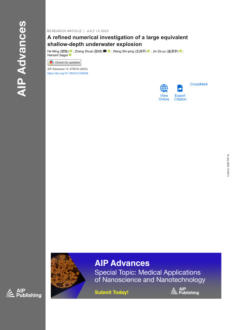


Publisher:
Vasiliy E. Nikulin, Sergey G. Parshin, Alexey M. Levchenko,
Gennadiy N. Vostretsov, Ilia L. Repin
The development of underwater technologies and
exploration of Arctic and Caspian shelves involve the use
of marine metal structures made from high-strength steel.
Research on underwater wet welding is crucial for
ensuring the quality of welded joints in high-strength
steel, particularly due to factors like temperature gradient,
rapid cooling rate, stiffness conditions, microstructure
heterogeneity, residual welding stresses, and hydrogen
effusion affecting the likelihood of cold crack growth in
welded joints.
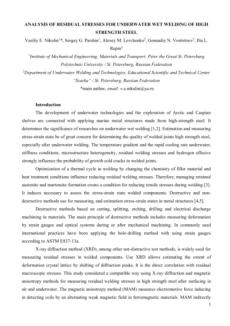


Publisher: UDECO AS - https://www.udeco.no/
The Udecom Tie-on System is a versatile tie-in system that
can handle single and multiple bores. It includes the
spool, connections, protection, and installation, all with
unique features. This system allows for loading and
installing multiple tie-in spools simultaneously. It also
facilitates the quick recovery of spools and is compatible
with connection systems from major suppliers.

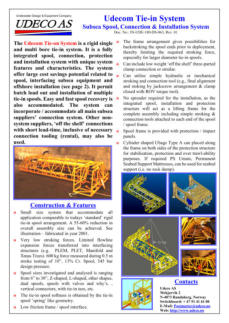


Authors: Rui Yang, Qian Kong, Meng Ren, Fuquan Ji, and
Dejie Li
The process of tunnel excavation is susceptible to the
formation of segment cracks, which can result in serious
safety hazards. The objective of this study is to examine
the nature, placement, and timing of cracks in a large-
diameter subaquatic shield tunnel while also identifying
their root causes. Furthermore, this research analyzes the
connections between crack features and parameters
associated with shield tunneling processes.

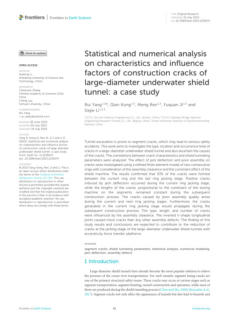


Click on the
octopus to return to
the top of the page


Publisher:
Shaowei Zhang , Chuan Tian, and Fenghua Zhou)
This article describes the design and optimization of a
hybrid mooring buoy observation system, named
Mooring Buoys Observation System with Benthic Electro-
Optical-Mechanical Cable (MBOSBC), for long-term deep-
sea monitoring. It explains the system's components,
particularly the Electro-Optical Mechanical (EOM) cable,
which is crucial for both mooring and energy
transmission and data between the seabed and the sea
surface. It also addresses the challenges faced by the
EOM cable under environmental loads. It describes the
mooring system's design criteria and optimization process
to ensure its long-term effectiveness and reliability.
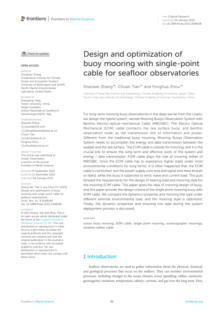


Authors: Fei Tian, Erfeng Zhang, Chen Yang, Dehua Sun,
Weidong Shi, and Yonghua Chen
This article presents research findings on the optimal
design of the mixing flow field of submersible mixers,
specifically focusing on improving the mixing uniformity
of activated sludge in the context of water pollution
control. The text discusses using numerical simulations to
analyze the flow field characteristics of solid-liquid two-
phase flow at various installation heights. The authors also
highlight the impact of installation height on flow
patterns, particle mixing, and aggregation, providing
theoretical insights for better engineering practices.
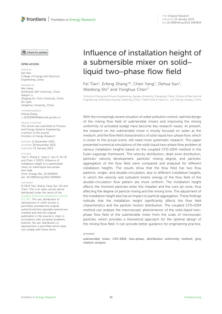


Authors:
Zhang Baofeng, Dong Rui, Wang Gang, Wang Guojun,
and Zhang Dayong
This study focuses on the dynamic interaction between
ice and the structure, particularly in the Bohai Sea, and
explores strategies to enhance wind turbines' safety and
operational stability. The research involves analyzing a
simplified mechanical model of a damping vibration
isolation system and determining the effectiveness of
different damping ratios in controlling structural
displacement and acceleration. The findings aim to guide
the design of ice-resistant offshore wind turbine
foundations.
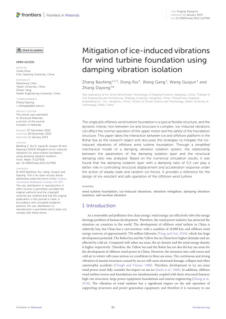


Authors: Fali Huo, Jie Xu, Hongkun Yang, Zhaojun Yuan,
and Zhongxiang Shen
This article describes research findings on designing and
performing a multi-point mooring system for floating
offshore wind turbines in shallow water areas (30 m–50
m depth). It focuses on the challenges posed by complex
environmental conditions and topography in shallow
waters and proposes a hybrid mooring cable scheme to
provide theoretical guidance for designing mooring
systems for floating offshore wind turbines in such
environments.
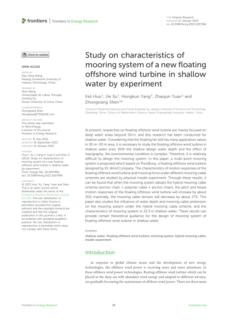


Authors: Xingda Ji, Tao Zou, Xu Bai, Xinbo Niu, and
Longbin Tao
This study analyzes the impact of initial flatness
divergence on the structural response and fatigue
damage of bolted ring flange connections in offshore
wind turbines. It involves modeling and simulating the
responses of both fixed and floating offshore wind
turbines to environmental loads. It also evaluates the
consequences of geometric imperfections on the flange
connections' structural integrity and fatigue life.
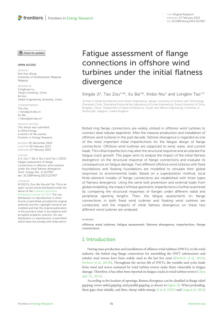


Authors: Shengjie Rui, Haojie Zhang, Hang Xu, Xing Zha,
Mengtao Xu, Kanmin Shen
This study reviews the development, installation, and
operation of various deep-sea infrastructures used to
exploit energy and mineral resources. It summarizes the
types of seabed structures and foundations, analyzes the
design requirements, marine environmental loads, and
applications of these infrastructures, identifies research
gaps, highlights the importance of marine environmental
conditions, geological conditions, and soil-structure
interactions, and suggests further research.
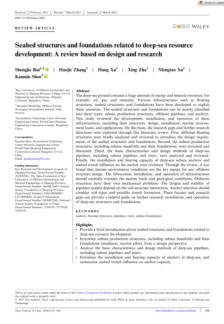


Authors: Mehdi Hajinezhadian & Behrouz Behnam
This study advocates for a probabilistic-based approach to
life-cycle cost (LCC) analysis in the design of offshore
platforms. The text aims to demonstrate that considering
LCC in the design process can lead to more cost-effective
and optimal structural designs over the platform's lifetime.
It highlights the potential benefits of slightly increasing
initial construction costs to significantly reduce lifetime
costs, encouraging stakeholders to adopt LCC-based
design methodologies for critical infrastructure.
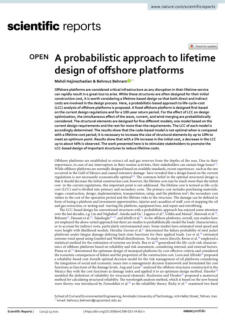


Authors: Samuel Lensgraf, Devin Balkcom, Alberto
Quattrini Li
This document describes a new free-floating autonomous
underwater construction system, highlighting its
capabilities, including active ballasting for efficient
transportation of cement building blocks, its unique
combination of compressed air for buoyancy and a
battery for thrusters, and its performance in construction
trials. Additionally, the authors discuss the system's
innovative components, such as a one-degree-of-freedom
manipulator, a two-component cement block
construction system, and a simple active ballasting system.



Authors: Xue-feng Zhang, & Chun-xia Song
This study focuses on safety monitoring and real-time
early warning technology for deep water high pile
foundations of bridges. It involves investigating typical
damage characteristics, proposing early warning indices
and thresholds, and establishing an evaluation model.
The research is applied to a specific project (the Jiashao
Bridge in Zhejiang Province, China) to verify the
effectiveness of the proposed system.
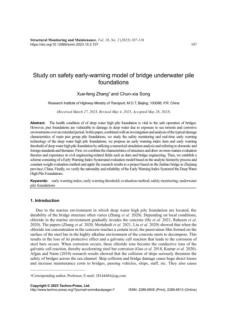


Authors: Fei Tian , Chen Yang, Erfeng Zhang, Dehua Sun,
Weidong Shi, & Yonghua Chen)
This study discusses improving the performance of
submersible mixers in sewage treatment by optimizing
their installation position parameters. It aims to enhance
the treatment pool's average flow velocity and mixing
efficiency and details the use of various software tools for
multi-objective optimization. The authors indicate
significant improvements in flow velocity, mixing
efficiency, and fluid distribution, suggesting that the
optimized installation positions can lead to better
operational efficiency and economic benefits in sewage
treatment plants.

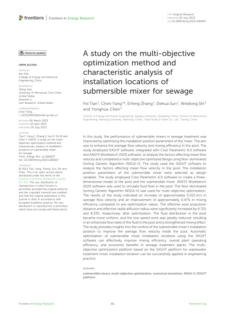


Authors: Qiushi Hu, Heng Li, Guang Wang, and Lei Li
This study combines a micro-scale three-dimensional
fractal model with a macro-scale finite element simulation
method to establish an equivalent torsional stiffness
model. It also discusses the construction of a torsional
stiffness testing platform, validates the proposed model
through experimental results, and examines the
influences of torque, installation eccentricity, and
deformation coefficient on the torsional stiffness.

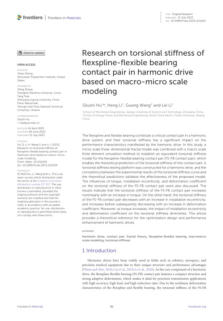


Authors:
Hsi-Hien Wei, Yuting Zhang, Ximing Sun, Jiayu Chen,
Shixian Li
This text provides an overview and analysis of the current
state and future potential of robotics and human-robot
collaboration in the construction industry. It highlights the
technological advancements, reviews developments,
discusses challenges, and proposes future research
directions in this field.
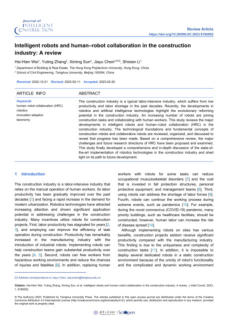


Authors: G S Ammosov, Z G Kornilova, Yu A Yakovlev
This text analyzes the design and structural challenges
associated with the underwater crossing of the trunk gas
pipeline (TGPL) across the river Lena in the Republic of
Sakha (Yakutia). It focuses on the impact of
hydromorphological and hydrological factors on the
pipeline's integrity, highlighting issues such as scours,
sagging, and tensile stresses that result from these
environmental conditions. The text also points out past
design and construction oversights and their
consequences on the pipeline's functionality and safety.
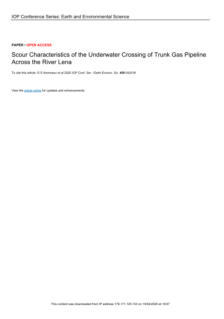


Authors:
Tianshuo Xu, Le Wang, Peng Zhang, Yuheng Zhou,
Kaixin Liu, Xin Feng, Yongchun Qi and Cong Zeng
This article aims to provide information about the
advancements and application of the direct pipe laying
method, combining the technical advantages of
horizontal directional drilling and pipe jacking
construction. It discusses the benefits of this method, such
as efficiency and minimal land use, and examines its
implementation through a case study. Additionally, it
analyzes technical aspects like equipment selection,
guiding control technology, and factors affecting thrust
force and trajectory deviation.
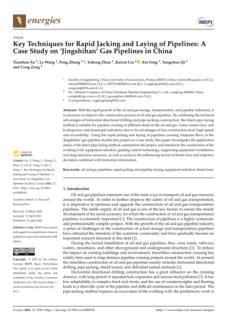


Author: V. Balaram
This paper reviews the various analytical techniques used
in the research, exploration, and analysis of Rare Earth
Elements (REE). It highlights the importance of these
techniques across different stages of REE-related activities,
discusses advancements in analytical instrumentation,
and emphasizes the use of both laboratory-based and
portable techniques for practical REE analysis to inform
readers about the current state and developments in
analytical methods for REE, with examples and
applications in research studies.

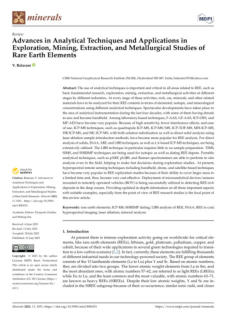


Authors: Nadia A. Genovese, Francis Andreas Lee
Kjærsgaard
This text describes the research and design process for
alternative scour protection options for a project facing
extreme environmental conditions. It details the testing
and evaluation of different solutions, such as geotextile
bags and rock bags, and the challenges encountered,
particularly with scaling and construction feasibility. It also
outlines the final composite solution adopted, combining
rock bags and an armor rock berm, highlighting the
design challenges and constructability considerations
involved.

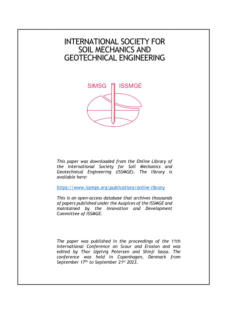


Authors:
Ming Ju, Yang Jiang, Feihong Yun, Hongwei Chai, Xi
Chen, ingxuan Zhang, and Liquan Wang
This text intends to present a detailed analysis and
findings from a study on the dynamic behavior of
submarine pipelines during the R-lay method. It aims to
describe the methodology used, specifically a finite
element-based shell element model, and the results of
simulations regarding pipeline bending moments and
ovality. It also highlights the influence of factors such as
the pipeline's diameter–thickness ratio and material
properties on these dynamic responses.

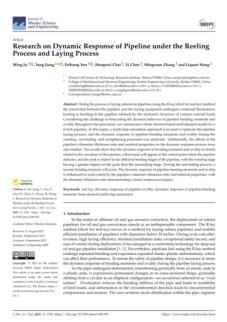


Authors:
Haixia Gong, Zhuoran Ping, Tong Zhao, Shuping Hou,
Fuqiang Zu, Pengyue Qiu, and Jianguo Qin
This study focuses on optimizing technology for recycling
abandoned undersea pipelines. It highlights the
importance of reducing costs, minimizing ocean
pollution, and improving recycling efficiency. It details the
examination of the anchoring theory and damage
process involved in submerged pipeline recovery, and it
describes the use of a multi-objective genetic algorithm to
optimize the design of the contact body structure in
recovery tools to ensure that the optimized design can
effectively exert contact force on the pipeline's inner wall,
with specific design parameters provided as a result of
the optimization process.

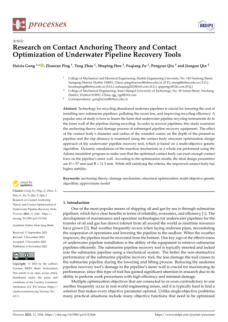


Authors: O.G. Kapinos, and N.V. Tvardovskaya
This text discusses the challenges and considerations in
designing and operating pressure hydraulic transport
systems in permafrost conditions. It identifies factors
affecting the risk of hydraulic shocks in pressure pipelines,
particularly during aboveground laying in permafrost
areas. It also emphasizes the importance of preventive
measures to avoid hydraulic shocks, which are more cost-
effective than dealing with the consequences of such
events.

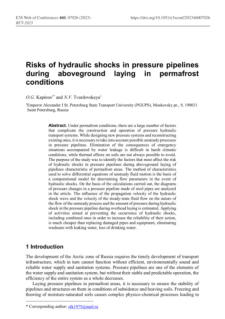


Authors:
Haixia Gong, Tong Zhao, Xiaofeng You, Liquan Wang,
and Feihong Yun
This paper explains the process and rationale behind
using scaled model experiments to verify the design of a
deep-sea flexible pipeline-laying system. It discusses the
need for physical simulation experiments due to the
complex marine environment. It highlights the use of
similarity theory to ensure that the scaled model
accurately represents the prototype.

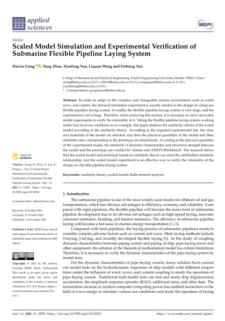



01 - Design study of offshore floating wind and photovoltaic power
generation platform.
Authors: Siqi Chen, Zijia Wang, and Wenxin Yang
The oceans hold a large amount of clean energy, mainly
from wind and solar power. This text presents a new
design for an offshore semi-submersible platform that
addresses issues like low stability and efficiency. It
combines a floating wind turbine with solar power,
details the design and materials, and calculates stability,
loads, and costs.The research enhances future green
energy sources at sea and improve floating platform
designs for better stability, economy, and efficiency.
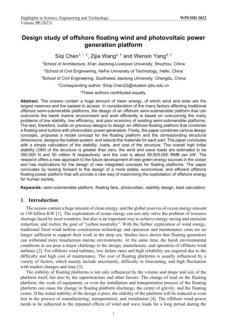



09 - A high-performance framework for personal protective
equipment detection on the offshore drilling platform.
Author: Xiaofeng Ji1, Faming Gong, Xiangbing Yuan,
Nuanlai Wang
Workers on offshore drilling platforms must regularly
maintain equipment, but the environment poses hazards.
Personal protective equipment (PPE) like helmets reduces
injury risk. Current detection methods mainly check for
helmet usage. This paper presents a new high-speed PPE
detection method that accurately identifies workers not
wearing helmets or workwear. An intelligent surveillance
system based on this model has been implemented.
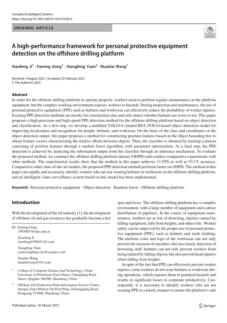



10 - A New Methodology for Upscaling Semi-submersible Platforms
for Floating Offshore Wind Turbines.
Authors: Kaylie L. Roach, Matthew A. Lackner, James F.
Manwell
This paper introduces a new method for upscaling semi-
submersible floating offshore wind turbine platforms.
Wind turbine sizes have increased significantly, and
assessing further growth is essential. The study develops a
hydrodynamic model validated with OpenFAST software,
applying the methodology to two case studies. Results
show that platform dimensions scale down by a factor of
0. 75, while steel mass increases by a factor of 1. 5,
contributing new insights into the upscaling of these
platforms.
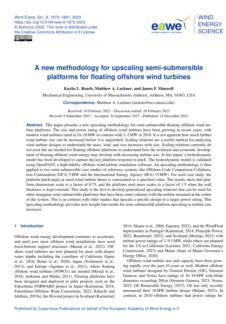



11 - The Study of the Lifting Arm System and Its Experimental Model
for Integrated Offshore Platform Decommissioning.
Authors: Changjiang Li, Wensheng Xiao, Teng Wang,
Xianglin Qu, Quan Li, and Lianghuan Fan
As offshore oil and gas resources are further exploited,
many fields are unable to meet production requirements,
making the decommissioning of offshore facilities urgent.
This article examines the lifting arm system for
decommissioning ultra-large offshore platforms as part of
a government program. A prototype structure is
analyzed, and a model is built to test its strength and
suitability for operations. This research is a
groundbreaking step in China, paving the way for future
experiments and equipment development.




13 - Experimental Study of a Puncture Warning System for a Jack-Up
Offshore Platform.
Authors: Zailiang Liu, Xiaobin, Yuelin Song, Yonghe Xie,
Detang Li
During the operation of jack-up offshore platforms,
changing seabed conditions can cause accidents like pile
leg punctures and platform tilt. This study aims to
introduce an early warning method for these issues to
ensure safety. A real-time monitoring system using a
programmable logic controller collects data from sensors
on displacement, tilt, and pressure. An experimental
device simulates a jack-up platform to assess safety
responses under various conditions. The system effectively
detects tilt and maintains safety.
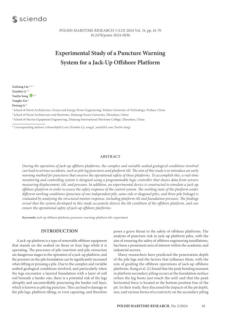



19 - Research on complex multimodal vibration characteristics of
offshore platform.
Authors: Na Wang, Ran Liang, Lei Li, Zhigang Liu, and
Zhe Zhao
The vibration and noise of offshore platforms affect staff
comfort and health and are key indicators of platform
status. This article studies the vibration characteristics and
transfer laws of semi-submersible platforms through
theoretical analysis and simulations, focusing on vibration
transmission and multimodal vibration mechanisms.
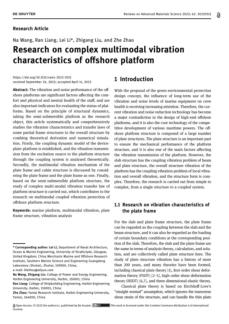



20 - Design and Mechanical Characteristics Analysis of Deep Sea
Manifold System
Authors: Chuxiang Lin, Weili Wang, Yongmei Zhu, Jian
Zhang , Suzhou Zhang, Longhui Wang
Subsea manifolds are crucial for offshore oil and gas
extraction. This study focuses on designing a double well
groove and double collector manifold for deep sea
conditions. It includes stress analysis using AutoPIPE
software, confirming compliance with ASME standards.
Buckling analyses reveal that early defects significantly
affect pipe strength. The findings serve as a reference for
deepwater manifold design technologies
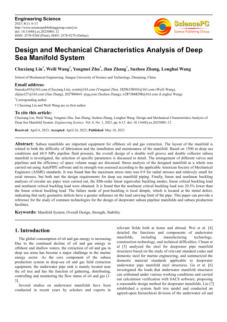
Authors: Mehdi Hajinezhadian, & Behrouz Behnam
Offshore platforms are crucial infrastructure, and
disruptions can lead to significant losses. The text suggests
using a lifetime-based design approach, considering both
direct and indirect costs. A probabilistic method for life-
cycle-cost (LCC) analysis is proposed, examining five
design models. Results show a need to increase structural
element sizes for optimal cost efficiency, leading to a
potential 46% decrease in LCC with only a 5% increase in
initial costs. The aim is to encourage stakeholders to adopt
LCC-based designs for important structures.


21 - A probabilistic approach to lifetime design of offshore platforms
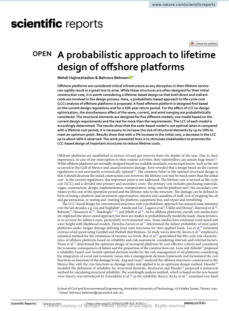



22 - Hydrodynamic Investigation on Floating Offshore Wind Turbine
Platform Integrated with Porous Shell.
Authors: Yisheng Yao, Dezhi Ning, Sijia Deng, Robert
Mayon, and Ming Qin
As wind turbines move from shallow to deep-water
locations, improving the stability of floating offshore wind
turbines (FOWTs) is important. A new spar-buoy with a
porous shell was designed by combining a traditional
marine structure. Numerical models were created to
study the motion responses and compared with the OC3-
Hywind spar. Results showed that the porous shell
reduced motion in all directions, especially heave, making
it a promising option for deep-sea FOWTs.
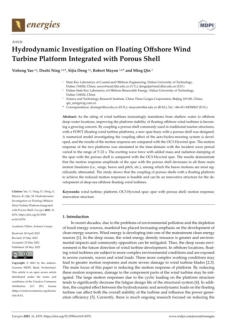



23 - Predicting offshore workability for platform supply vessels using
IoT and machine learning.
Author: R.F. Dick
The North Sea offshore oil and gas production platforms
require supply vessels for regular delivery of materials,
including food, water, and fuel. Weather conditions can
disrupt vessel schedules, leading to higher operational
costs and safety concerns for crew members waiting in
adverse conditions. Vessel motion prediction is often
overlooked due to modeling costs. However, using IoT
sensor data from vessels and local metocean information,
machine learning models achieved 88%-91% accuracy in
predicting motion parameters like roll, pitch, and heave.
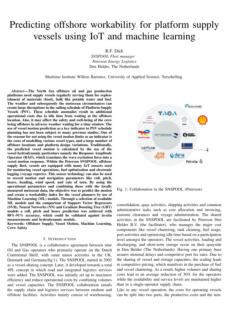



32 - Evaluation of safety monitoring scheme for offshore floating
platform based on the multiple connection numbers.

Authors: Guo Liu, Qiyue Guo, Yanqiang Bai
This paper developed a five-element connection number
analysis method to evaluate the safety monitoring
scheme of offshore floating platforms. An index system
was created, and Set Pair Analysis was used for similarity,
difference, and reverse evaluation. The entropy weight
method helped calculate objective weights. A case study
on an offshore platform project in Guangdong, China
showed good evaluation results, highlighting the
programming method's importance. The findings offer a
theoretical basis for managing safety monitoring
schemes.
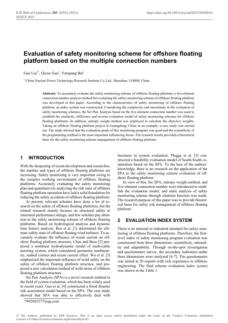

Authors: Directorate of Fisheries Government of Goa
Sea cage culture involves growing fish in enclosed nets in
the sea for water flow. It can be done in appropriate
areas with government permission. Production is much
higher than shore systems, and costs are lower.
Monitoring fish is easy, helping prevent stress and disease.
Harvesting can be planned based on demand for better
quality and price.


33 - A manual on open sea cage culture.
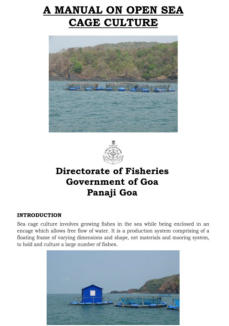



34 - Offshore Platforms: Classification, Technologies, Architectures,
and Applications.
Author: An Chen
Offshore platforms face challenges from the marine
environment and support oil production, wind energy,
and research. This paper summarizes current research,
types, applications, and technological aspects of offshore
platforms, highlighting their adaptability and potential for
improved performance.
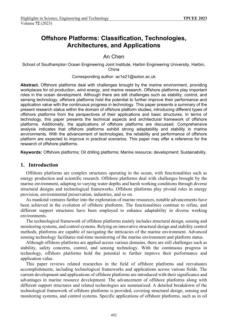



35 - Methodology for the Formation of a Digital Model of the Life
Cycle of an Offshore Oil and Gas Platform.
Authors: Nikolay Didenko, Djamilia Skripnuk, Viktor
Merkulov, Kseniia N. Kikkas, and Konstantin
Skripniuk
This article organizes scientific views on creating a digital
model for complex engineering systems, focusing on
offshore oil and gas platforms. It discusses key elements of
the platform's life cycle model and advocates for an
interdisciplinary approach using alternative graphs and
information technologies. New concepts like life cycle cost
and duration are introduced. The article details a
proposed technology for model-based design and
outlines a cyclic procedure for managing the virtual life
cycle model, which updates with changes and reduces
the need for extensive physical testing.
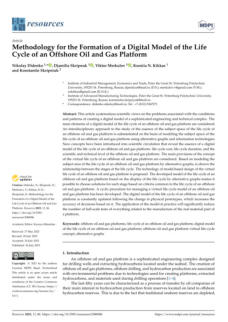



42 - Italian Offshore Platform and Depleted Reservoir Conversion in
the Energy Transition Perspective.
Authors: Andrea Carpignano, Raffaella Gerboni, Alessio
Mezza, Candido Fabrizio Pirri, Adriano Sacco,
Daniele Sassone, Alessandro Suriano, Anna
Chiara Uggenti, Francesca Verga, and Dario
Viberti
New ideas for reusing old platforms have been studied,
focusing on changing them from recreational tourism to
fish farming. This paper discusses options relevant to Italy,
supporting a national strategy for a circular economy and
energy transition. Options include renewable energy
production, hydrogen from seawater, CO2 capture, and
fluid storage. The study shows that converting offshore
platforms can meet energy goals without technical,
environmental, or safety issues. Socio-economic factors
were not reviewed.
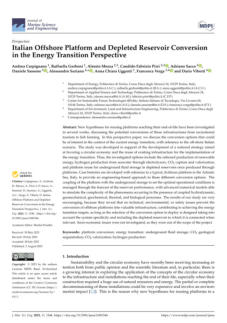



43 - Debottlenecking The Complexities of Stakeholder Management
in Indonesia Offshore Platform Decommissioning
Authors: Desi Aresa Mahdi, Gatot Yudoko, and Agung
Wicaksono
Indonesia's offshore platform decommissioning is
complicated, involving many stakeholders with differing
interests. Only one platform has been removed and sunk
as rig-to-reef since 2017. Research identified challenges
like the lack of an Abandonment and Site Restoration
Fund and regulatory weaknesses. Solutions include
formalizing funding and creating a comprehensive
regulation.
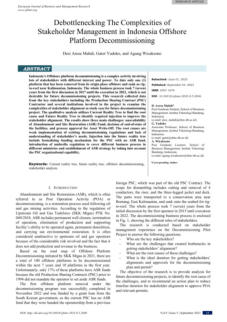



44 - Performance Feasibility of a Multi-Source Offshore Renewable
Energy Platform for Aquaculture
Authors: Sophie Roberts, Damon Howe, Jean-Roch
Nader
The global aquaculture industry faces challenges due to
the rising demand for seafood. Issues include less
available coastal areas and the need to reduce
environmental harm. Moving operations offshore could
help, but energy supply is a major challenge. This paper
examines a new renewable energy platform using solar,
wind, and wave energy off Tasmania, assessing its
feasibility through a numerical model.
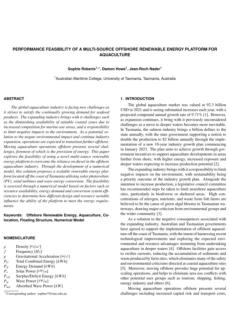



45 - Sensitivity Analysis of Offshore Platform Structures Under
Varying Scour Depths
Authors: Made Suarjana, and Willy Kiesin
Several offshore platforms in the Java Sea have
encountered scour at different depths, raising safety
concerns. Scouring erodes around these structures and
impacts their integrity. Sensitivity analysis helps understand
how scour affects safety parameters. A study using SACS
software analyzed a four-legged jacket platform under
storm and seismic conditions, revealing that safety factors
decrease as scour depth increases. This research aids
engineers in maintaining offshore platforms safely amidst
scour challenges.




48 - Hydro-structural design exploration of floating platform for
offshore energy systems.
Authors: Chandler S. Cain, Yong Hoon Lee
This paper explores the design of floating platforms for
offshore energy systems. It aims to create a design
method that maintains stability against ocean waves
while meeting structural constraints. The design focuses
on free-form outer columns to improve performance and
uses spline interpolation for the hull shape. The study
includes simulations to assess dynamic responses and
offers design insights for developers. It emphasizes
advanced shape optimization, manufacturability, and
consideration of wave conditions for effective
performance.
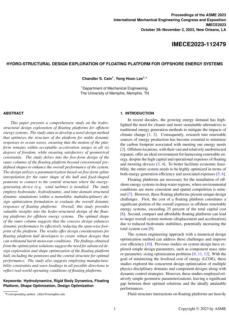



49 - Simulation of Offshore Wind Turbine Blade Docking Based on
the Stewart Platform.
Authors: Yi Zhang, Jiamin Guo, and Huanghua Peng
The main issue affecting offshore wind turbine installation
is wind. This paper uses a Stewart platform to enhance
the stability and efficiency of single-blade installation in
high winds. A simulation system was created to test its
effectiveness, using a PID algorithm to control the
platform. The simulation, involving 61. 5-meter blades,
shows the system can improve docking by reducing
vibration and movement, leading to more stable and
efficient blade installation.
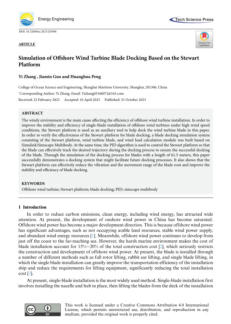



51 - Design Optimization of a Mooring System for an Offshore
Aquaculture Platform
Authors: Liang Wang, Lei Wang, Mingchao Cui,
Mingxiao Liang, and Haitian Liu
In this paper, the mooring system of an offshore
aquaculture platform is designed and improved using a
shallow water mooring system method that combines
NSGA-II and a cable–platform model. The study compares
the hydrodynamic performance of three mooring systems
using numerical simulations and physical experiments,
confirming the effectiveness of the NSGA-II designed
system as a cost-effective solution.
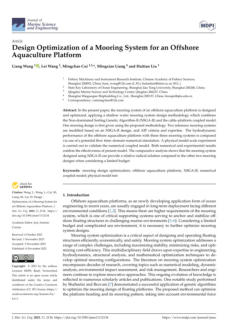



52 - Ice-Induced Vibration Analysis of Offshore Platform Structures
Based on Cohesive Element Method.
Authors: Jianhua Zhang, Xiaoyu Wang, Ke Sun, Yueqi
Lai, Dianwei Gao, Won-Hee Kang, Bin Wang,
and Bingjun Wang
This study examines ice-induced vibration on offshore
platforms using the cohesive element method (CEM). The
method's effectiveness is confirmed by comparing it to
the HSVA ice-breaking experiment. The investigation
shows that offshore platform motion correlates with ice
impact velocity, but sensitivity is low. Ice direction
significantly affects vibration response, and using 52.5-
degree cones reduces acceleration by 63%. Higher cone
angles result in greater load-bearing.
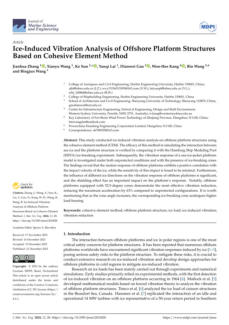



53 - Mothballing, Manifold, Pipeline installation and Impact
Assessment in existing Saghara Gas solution Flowstation Facility,
Warri, Niger Delta, Nigeria.
Authors: Ibrahim O.I., Ngozi-Chika C.S., Okanigbuan P.N.,
Abdulraheem K.K., and Bilqees D.
The Saghara field is in OML 43, Warri South, with 8 wells,
two of which are abandoned. It produces 30,000 barrels
of oil per day and is part of a gas flaring reduction
project. Oil wells have been rerouted, and a new inlet
manifold has been installed. Key findings include new
pipelines for gas collection, installation of a 21km fiber
optic cable, and mothballing of the flowstation.
Hydrostatic tests showed no leaks, and gas flaring will
significantly reduce.
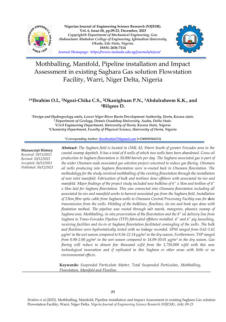



12 - Distributed Dynamic Coordination Control for Offshore Platform
Transportation Under Ocean Environmental Disturbances
Authors: Zhe Du, Rudy R. Negenborn, and Vasso Reppa
The article proposes a distributed dynamic coordination
control scheme for a multivessel autonomous towing
system for transporting large offshore platforms under
environmental disturbances. The control scheme uses a
multilayer model-predictive control strategy with specific
cost functions and an alternating direction method of
multipliers with augmented Lagrangian function. The
simulation experiment shows improved consensus and
efficient transportation under environmental
disturbances.
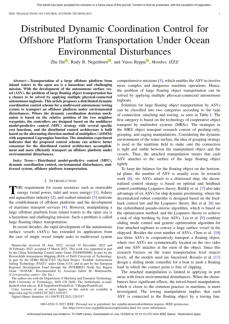



27 - Regularities of fatigue failure typical composite flange
Author: D.G. Solomonov, N.A. Sazhenkov, I.P. Konev,
M.Sh. Nikhamkin, A.V. Toropicina
This study examines fatigue failure patterns of an L-
shaped flange made of laminated carbon fibre in shell
aircraft structures. The fatigue testing method reproduces
operational conditions of flange loading, revealing
characteristic patterns of delaminations and a drop in
resonant frequency due to decreased rigidity. These
experimental data can be used for designing CFRP
flanges and predicting fatigue life.
This document is written in Russian
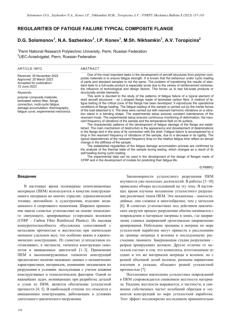



41 - Research on residual stress and hydrogen diffusion of X80
pipeline welded joint
Authors: Jinghong Xue, Andun Cheng, Chenxu Bai, and
Li Ji
Hydrogen enrichment in pipelines is a significant issue
affecting their safe service. A previous study using
ABAQUS software analyzed the impact of welding
residual stress on hydrogen diffusion and heat treatment.
This study found that hydrostatic stress is the main driving
force for hydrogen diffusion in the pipeline. It also found
that hydrogen enrichment occurs in inclusions or
boundaries before and after heat treatment, with hard
inclusions having higher internal hydrogen
concentrations. Post-weld heat treatment can significantly
reduce welding residual stress and hydrostatic stress,
thereby reducing hydrogen enrichment concentration.
